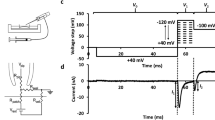Summary
The aim of the present investigations was to see if the membrane depolarizing action of cardiac glycosides which has been observed previously in excised frog skeletal muscles can be demonstrated in the living animal, and if so, to try to assess whether or not it is merely a toxic manifestation.
Resting potentials (R. P.) were measured in situ with conventional glass microelectrodes in sartorius muscles of urethane narcotized frogs. The mean R. P. in untreated control frogs was 93–94 mV; this is about 4–5 mV higher than the values found in excised muscles. In the control muscles no significant change in the mean R. P. was detected over periods of 30–60 hours.
The injection of 100–500 μg/kg of strophanthin produced a highly significant depression of the R. P. of 8–12 mV. There was no evidence of any dose dependence in this range of concentrations. Contrary to previous experience in vitro, this depolarizing effect of strophanthin was reversible in the living animal. The duration of the action was dependent on the quantity of strophanthin injected and lasted from about 6 hours (100 μg/kg) to about 50 hours (300 μg/kg). The dose of 500 (μg/kg caused the death of all frogs, however the R. P. at 10 hours was not lower than in frogs treated with smaller non fatal doses; it was only in the final phase that the R. P. was further reduced.
The electrocardiograms were recorded to see if the membrane depolarizing action of strophanthin was necessarily associated with evidence of a toxic effect on the heart. The highest doses of strophanthin (400–500 μg/kg) usually caused marked changes in the ECG, which is clear evidence of toxic levels of the drug, while 200 (μg/kg and lower doses had no significant influence on the ECG. Thus as far as can be judged from the ECG recordings the membrane depolarizing action of strophanthin can occur at subtoxic levels of the drug and would presumably occur with therapeutic levels.
The muscles were dissected out either during the phase of maximum R. P. depression or after recovery from the glycoside and analysed for their sodium and potassium content. Neither narcosis, even after periods of up to 3 days, nor treatment with strophanthin (50–300 (μg/kg) caused any demonstrable change in the intracellular ionic concentrations. The membrane depolarizing action of strophanthin was ascribed to a change in the membrane permeability mechanism.
Similar content being viewed by others
Literatur
Bennett, A. L., Ware, F., Jr., Dunn, A. L., McIntyre, A. R.: The normal membrane resting potential of mammalian skeletal muscle measured in vivo. J. cell. comp. Physiol.42, 343–357 (1953).
Cho, L. L., Shy, G. M., Wells, J.: Some properties of mammalian skeletal muscle fibres with particular reference to fibrillation potentials. J. Physiol. (Lond.)135, 522–535 (1957).
Conway, E. J.: Nature and significance of concentration relations of potassium and sodium ions in skeletal muscle. Physiol. Rev.37, 84–132 (1957).
Draper, M. H., Friebel, H., Karzel, K.: The changes in ionic composition and resting and action potentials in frog sartorius muscle fibres maintained in vitro. J. Physiol. (Lond.)168, 1–21 (1963).
Karzel, K.: Der Einfluß von Pharmaca auf biochemische und biophysikalische Funktionen der Zellmembran. Habilitationsschrift, Bonn 1964.
—: Changes in the resting potentials of growing chicken skeletal muscles. J. Physiol. (Lond.)196, 86–87P (1968).
—, Draper, M. H.: Untersuchungen über den Einflu\ von Cardenoliden auf Membranfunktionen von Skeletmuskelzellen in vitro. Naunyn-Schmiedebergs Arch. Pharmak. exp. Path.261, 458–468 (1968).
— —, Friebel, H.: Beitrag zum Wirkungsmechanismus der Lokalanaesthetica. Naunyn-Schmiedebergs Arch. exp. Path. Pharmak.250, 405–418 (1965).
Kleeman, F. J., Partridge, L. D., Glasser, G. H.: Resting potential and distribution of muscle fibers in living mammalian muscle. Amer. J. phys. Med.40, 183–191 (1961).
Lendle, L., Mercker, H.: Extrakardiale Digitaliswirkungen. In: Ergebnisse der Physiologie, Biologischen Chemie und exper. Pharmakologie, Bd. 51, S. 199–298 Berlin-Göttingen-Heidelberg: Springer 1961.
Ling, G., Gerard, R. W.: The normal membrane potential of frog sartorius fibres. J. cell. comp. Physiol.34, 383–406 (1949).
McIntyre, A. R., Bennett, A. L., Hinman, J. S.: Fibrillation in dystrophic muscle. Physiologist1, 59 (1957).
Nastuk, W. K., Hodgkin, A. L.: The electrical activity of single muscle fibres. J. cell. comp. Physiol.35, 39–74 (1950).
Trautwein, W., Zink, K., Kayser, K.: Über Membran- und Aktionspotentiale einzelner Fasern des Warmblüterskeletmuskels und ihre Veränderung bei der Ischämie. Pflügers Arch. ges. Physiol.257, 20–34 (1953).
Ware, F., Jr., Bennett, A. L., McIntyre, A. R.: Membrane resting potential of denervated mammalian skeletal muscle measured in vivo. Amer. J. Physiol.177, 115–118 (1954).
Westermann, E.: Zur Digitaliswirkung auf die neuromuskuläre Übertragung. Naunyn-Schmiedebergs Arch. exp. Path. Pharmak.222, 398–407 (1954).
Author information
Authors and Affiliations
Rights and permissions
About this article
Cite this article
Karzel, K. Membranruhepotential und Elektrolytgehalt von Froschskeletmuskeln in situ und ihre Beeinflussung durch g-Strophanthin. Naunyn-Schmiedebergs Arch. Pharmak. 270, 237–247 (1971). https://doi.org/10.1007/BF00997024
Received:
Issue Date:
DOI: https://doi.org/10.1007/BF00997024




